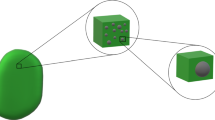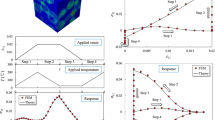Abstract
Particle-reinforced composites (PRCs) are usually studied by some averaging or homogenization techniques. In this, the effective properties are derived by assuming that particles are dispersed within composites according to some given (probabilistic) distribution. Such approaches restrain the possibilities of studying the contribution of exact location and parameters of individual particles to the overall behavior of composites. In this paper, we attempt to fill this gap by deriving the mesoscopic model of such composites corresponding to a continuum with point inhomogeneities. We start from a fully microscopic model where the composite is regarded as a continuum with spherical inclusions. Letting the diameter of inclusions decrease to zero, material parameters of the composite are represented in terms of the Dirac distribution. The Mindlin–Reissner–von Kármán thick plate theory is considered as a particular case, and closed-form formulas are obtained for the plate stiffness coefficients. Numerical analysis of a thick composite plate reinforced over its mid-surface justifies the theoretical derivations.





Similar content being viewed by others
References
German, R.M.: Particulate Composites: Fundamentals and Applications. Springer, Basel (2016)
Torquato, S.: Random Heterogeneous Materials: Microstructure and Macroscopic Properties. Springer, New York (2002)
Lewiński, T., Telega, J.J.: Plates, Laminates and Shells: Asymptotic Analysis and Homogenization. World Scientific Publishing, Singapore (2000)
Kamiński, M.: Computational Mechanics of Composite Materials. Sensitivity, Randomness and Multiscale Behaviour. Springer, London (2005)
Böhm, H.J., Eckschlager, A., Han, W.: Multi-inclusion unit cell models for metal matrix composites with randomly oriented discontinuous reinforcements. Computat. Mater. Sci. 25(1–2), 42–53 (2002)
Nazarenko, L., Stolarski, H.: Energy-based definition of equivalent inhomogeneity for various interphase models and analysis of effective properties of particulate composites. Compos. Part B 94, 82–94 (2016)
Nazarenko, L., Bargmann, S., Stolarski, H.: Closed-form formulas for the effective properties of random particulate nanocomposites with complete Gurtin–Murdoch model of material surfaces. Contin. Mech. Thermodyn. 29(1), 77–96 (2017)
Nazarenko, L., Stolarski, H., Altenbach, H.: Effective properties of particulate composites with surface-varying interphases. Compos. Part B 149, 268–284 (2018)
Nazarenko, L., Stolarski, H., Khoroshun, L., Altenbach, H.: Effective thermo-elastic properties of random composites with orthotropic components and aligned ellipsoidal inhomogeneities. Int. J. Solids Struct. 136–137, 220–240 (2018)
Picu, C.R., Sorohan, S., Soare, M.A., Constantinescu, D.M.: Designing particulate composites: the effect of variability of filler properties and filler spatial distribution. In: Trovalusci, P. (ed.) Materials with Internal Structure Multiscale and Multifield Modeling and Simulation, pp. 89–108. Springer, Berlin (2016)
Nazarenko, L., Chirkov, A.Y., Stolarski, H., Altenbach, H.: On modeling of carbon nanotubes reinforced materials and on influence of carbon nanotubes spatial distribution on mechanical behavior of structural elements. Int. J. Eng. Sci. 143, 1–13 (2019)
Berger, H., et al.: An analytical and numerical approach for calculating effective material coefficients of piezoelectric fiber composites. Int. J. Solids Struct. 42(21–22), 5692–5714 (2005)
Lin, Ch-H, Muliana, A.: Micromechanics models for the effective nonlinear electro-mechanical responses of piezoelectric composites. Acta Mech. 224(7), 1471–1492 (2013)
Ju, J.W., Chen, T.M.: Micromechanics and effective moduli of elastic composites containing randomly dispersed ellipsoidal inhomogeneities. Acta Mech. 103, 103–121 (1994)
Tong, J., Nan, C.-W., Fu, J., Guan, X.: Effect of inclusion shape on the effective elastic moduli for composites with imperfect interface. Acta Mech. 146(3–4), 127–134 (2001)
Nazarenko, L., Stolarski, H., Altenbach, H.: A definition of equivalent inhomogeneity applicable to various interphase models and various shapes of inhomogeneity. Procedia IUTAM 21, 63–70 (2017)
Kushnevsky, V., Morachkovsky, O., Altenbach, H.: Identification of effective properties of particle reinforced composite materials. Comput. Mech. 22(4), 317–325 (1998)
Altenbach, H.: Modelling of anisotropic behavior in fiber and particle reinforced composites. In: Sadowski, T. (ed.) Multiscale Modelling of Damage and Fracture Processes in Composite Materials. CISM International Centre for Mechanical Sciences (Courses and Lectures), vol. 474. Springer, Vienna (2005)
Altenbach, H., Altenbach, J., Kissing, W.: Mechanics of Composite Structural Elements, 2nd edn. Springer, Singapore (2018)
Muc, A., Barski, M.: Design of particulate-reinforced composite materials. Materials 11, 234 (2018)
Kamiński, M.: Deterministic and probabilistic homogenization limits for particle-reinforced composites with nearly incompressible components. Compos. Struct. 187, 36–47 (2018)
Wriggers, P., Hain, M.: Micro-meso-macro modelling of composite materials. In: Oñate, E., Owen, R. (eds.) Computational Plasticity. Springer, Berlin (2007)
Kamiński, M.: Homogenization of particulate and fibrous composites with some non-Gaussian material uncertainties. Compos. Struct. 210, 778–786 (2019)
Sokolovski, D., Kamiński, M.: Homogenization of carbon/polymer composites with anisotropic distribution of particles and stochastic interface defects. Acta Mech. 229, 3727–3765 (2018)
Ju, J.W., Yanase, K.: Micromechanics and effective elastic moduli of particle-reinforced composites with near-field particle interactions. Acta Mech. 215, 135–153 (2010)
Tartar, L.: The General Theory of Homogenization. A Personalized Introduction. Springer, Heidelberg (2009)
Nordmann, J., Aßmus, M., Altenbach, H.: Visualising elastic anisotropy—theoretical background and computational implementation. Contin. Mech. Thermodyn. 30(4), 689–708 (2018)
Sakata, S., Ashida, F.: Hierarchical stochastic homogenization analysis of a particle reinforced composite material considering non-uniform distribution of microscopic random quantities. Comput. Mech. 48, 529–540 (2011)
Quarteroni, A., Manzoni, A., Negri, F.: Reduced Basis Methods for Partial Differential Equations. Springer, Cham (2016)
Mikhlin, S.G.: Error Analysis in Numerical Processes. Wiley, Chichester (1991)
Pica, A., Wood, R.D., Hinton, E.: Finite element analysis of geometrically nonlinear plate behaviour using a Mindlin formulation. Comput. Struct. 11, 203–215 (1980)
Acknowledgements
The support of the State Administration of Foreign Expert Affairs of China is thankfully acknowledged. Valuable remarks of unknown reviewers allowed to improve the presentation of the results substantially.
Author information
Authors and Affiliations
Corresponding author
Additional information
Publisher's Note
Springer Nature remains neutral with regard to jurisdictional claims in published maps and institutional affiliations.
Rights and permissions
About this article
Cite this article
Khurshudyan, A.Z. Derivation of a mesoscopic model for nonlinear particle-reinforced composites from a fully microscopic model. Acta Mech 230, 3543–3554 (2019). https://doi.org/10.1007/s00707-019-02491-y
Received:
Revised:
Published:
Issue Date:
DOI: https://doi.org/10.1007/s00707-019-02491-y




